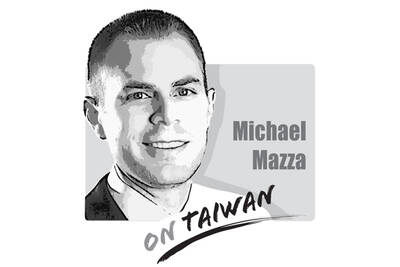What is the Chinese Nationalist Party’s (KMT) vision for Taiwan? An answer to this question is warranted after the KMT agreed to meet with Chinese President Xi Jinping (習近平) under the “one China” framework.
The cocktail of policies over the past five years further accentuates the need for an answer because they seem to be no more than tactical initiatives. The vision that these initiatives are serving is not stated and thus left open to interpretation. Uncertainty about Taiwan’s future is not what Taiwan needs as China’s international influence is growing rapidly.
The KMT’s policies and the “one China” framework must lead the international community to conclude that the KMT government is consciously or unconsciously directing Taiwan toward a Hong Kong model or even toward China. If this is the official policy, then KMT should be honest and state it clearly.
The KMT’s Taiwan policies are embedded in policies such as the nonexistent “1992 consensus” and the policy of no independence, no unification and no use of force. The problem with these policies are that they are empty phrases stating nothing about the KMT’s vision for Taiwan. Moreover, policies based on negations about what you will not do will never lead a country forward.
The lack of a vision for Taiwan has generated a friendly relationship with China, which has been recognized worldwide. However, if increased international space for Taiwan was a desired goal of these friendly relationships, the KMT has failed miserably.
Taiwan’s observer status is subject to annual approval from China and the Economic Cooperation Framework Agreement between Taiwan and China has not yet been sent to the WTO. Consequently, both achievements have lowered Taiwan’s international status.
The fundamental problem is that the KMT’s policies appear to mimic the policies of Hong Kong’s government. Hong Kong is fast becoming more Chinese and less uniquely Hong Kong. The consequence is that Taiwanese business has become an ally in the cross-strait policies and Taiwanese media has become increasingly influenced by Chinese agendas. Thus, China can influence Taiwan in many areas and its influence is growing.
However, Hong Kong’s development offers concrete lessons on how to resist China’s influence, and Taiwan’s politicians and civil society are already learning from Hong Kong. Civil society in Taiwan can play a significant role in resisting China’s policies. This requires that the otherwise inspiring demonstrations like the ones against media mergers and support for the Huaguang Community (華光社區) are elevated to questions about cross-strait policies and the future of Taiwan.
On the political level, politicians have to play a fine balance between resistance and cooperation with China. This requires bold leadership from the opposition parties and courage to safeguard the right for Taiwanese to determine their own future.
It is time for the Taiwanese to demand that their KMT government make a clear policy statement on its vision for Taiwan. The KMT is likely to fail on this.
It is interesting to observe that recently disclosed US files from March 1949 show that the CIA believed that the KMT “could not be relied upon to prevent the communists from gaining control of the island.”
Today, the files set the current cross-strait development and the KMT’s lack of a vision for Taiwan into historical perspective.
Michael Danielsen is the chairman of Taiwan Corner.
The US Senate’s passage of the 2026 National Defense Authorization Act (NDAA), which urges Taiwan’s inclusion in the Rim of the Pacific (RIMPAC) exercise and allocates US$1 billion in military aid, marks yet another milestone in Washington’s growing support for Taipei. On paper, it reflects the steadiness of US commitment, but beneath this show of solidarity lies contradiction. While the US Congress builds a stable, bipartisan architecture of deterrence, US President Donald Trump repeatedly undercuts it through erratic decisions and transactional diplomacy. This dissonance not only weakens the US’ credibility abroad — it also fractures public trust within Taiwan. For decades,
In 1976, the Gang of Four was ousted. The Gang of Four was a leftist political group comprising Chinese Communist Party (CCP) members: Jiang Qing (江青), its leading figure and Mao Zedong’s (毛澤東) last wife; Zhang Chunqiao (張春橋); Yao Wenyuan (姚文元); and Wang Hongwen (王洪文). The four wielded supreme power during the Cultural Revolution (1966-1976), but when Mao died, they were overthrown and charged with crimes against China in what was in essence a political coup of the right against the left. The same type of thing might be happening again as the CCP has expelled nine top generals. Rather than a

The ceasefire in the Middle East is a rare cause for celebration in that war-torn region. Hamas has released all of the living hostages it captured on Oct. 7, 2023, regular combat operations have ceased, and Israel has drawn closer to its Arab neighbors. Israel, with crucial support from the United States, has achieved all of this despite concerted efforts from the forces of darkness to prevent it. Hamas, of course, is a longtime client of Iran, which in turn is a client of China. Two years ago, when Hamas invaded Israel — killing 1,200, kidnapping 251, and brutalizing countless others
A Reuters report published this week highlighted the struggles of migrant mothers in Taiwan through the story of Marian Duhapa, a Filipina forced to leave her infant behind to work in Taiwan and support her family. After becoming pregnant in Taiwan last year, Duhapa lost her job and lived in a shelter before giving birth and taking her daughter back to the Philippines. She then returned to Taiwan for a second time on her own to find work. Duhapa’s sacrifice is one of countless examples among the hundreds of thousands of migrant workers who sustain many of Taiwan’s households and factories,